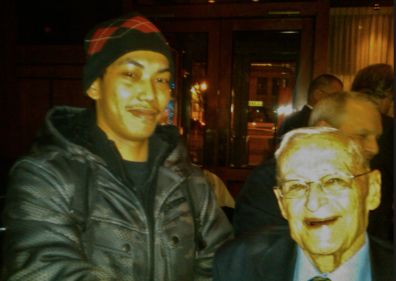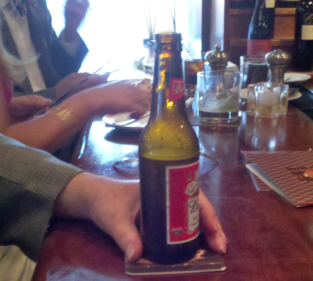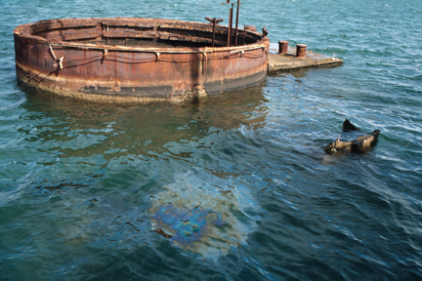OPINTEL
30 November 2016
Editor’s Note: We are back to Mac today. What strikes me as being amazing about the historic times that Mac talked about- all of them down the decades- is the speed with which things changed in his war. From the devastating attack at Pearl to the “turning point” at the battle of Midway was about seven months. I get the strangest feeling that we are living through one of those similar temporal fugue-states right now. I will be interested to talk to you about all this seven months from now.
– Vic
OPINTEL

(Willow Bartender Jasper Malig, of Guam, with a fellow, though temporary Guamanian (1945), Mac Showers).
Mac was intent about the ‘Winds’ messages. I had not meant to get into it, since it was an intellectual fight of long standing for a lot of people who are no longer alive. It was always in the background during the war, part of the long battle between the Navy and the Army code-breakers, and it burst out again, when the battle for reputation and honor was re-fought in Washington before the Joint Committee of Congress when the actual fighting was finally over.
I pushed the empty plate aside that had held the spring rolls and dipping sauce. Willow has its clock-work internal mechanisms tied to the lives of the people in the towers around it, and this afternoon was no exception. Old Jim the resident curmudgeon and my best pal at the bar came in and planted himself at the corner stool. He drinks Bud, in long necks, even though Tracy’s vision for her place is that of an upscale wine bar.

He is more than a bit like Norm on the epic bar-fly classic television show Cheers. I sometimes wonder what character I resemble, and hope it is not Cliff.
He waved, and distracted, I waved back. The line-up along the bar was decidedly more diverse than I remember the one being on television, what with the business guys and elegant ladies talking earnestly to one another, but I like it. I have been in a lot of bars in a lot of places in my life, but I have never enjoyed a place as much as I enjoy Tracy O’Grady’s Willow. I feel like it is my living room. It is that comfortable.
I slid onto a stool next to Mac, who was nattily attired in aloha shirt and sport jacket. He began today’s interview in mid-stream, based on an email exchange earlier in the day. “Captain Safford testified that he got the famous “East Wind, Rain” message, and that it was intercepted at the Security Group Station at Bainbridge Island. That was the message that was supposed to direct the Japanese diplomatic stations to burn their codes, and the die was cast. It was war.”
He crinkled his brow. “There is a whole body of literature about it now. The phrase ‘West Wind Cloudy’ was supposed to mean ‘war with Great Britain.’ ‘North’ was the Soviet Union, I think. Doesn’t matter. The message was never sent, or if it was, we didn’t get it in time to do anything with it. Historians have been chasing their tails over that since the war ended. There was a chief petty officer who was going to testify to Congress that he got the message and got it to Safford, but he was never called. The historical record is not what you think it is.”
“I know that from personal experience,” I said. I took a sip of Pinot Grigio as Willow continued its deliberate rhythm and ritual. The lights went down precisely at 5:15, even if there was plenty of daylight outside. The sudden dimness caused us to move closer, which I suppose is the point.
“See, the Combat Intelligence Unit, working from cramped spaces in the basement of the Naval District Headquarters at the Pearl Harbor Naval Shipyard was on the defensive from the day of the attack until they started to ramp up. This might be the most significant development of the war that no one talks about. What Joe Rochefort and Eddie Layton and Jasper Holmes did was create OPINTEL.”
I nodded in agreement. I am an acolyte of the craft pf operational intelligence, indoctrinated into the cult by the legendary Mike McConnell, the best analyst of his generation. He taught our cohort the craft that had been perfected there in Pearl in the months that Allis reeled backwards from the inexorable onslaught of the Japanese war machine.
In our era, to do OPINTEL properly, an analyst had to combine overhead imagery, acoustic data, sensitive and not-so-sensitive SIGINT and blend it with highly classified HUMINT to get a clue as to where the Soviets were sending their Boomers. We were pretty good at the craft, and directing our maritime patrol aircraft to count coup on them by dropping sonobuoys and buzzing around to let them know they had been had, and the gig would have been up, had we so desired.
But cool as we thought it was, the basic methodology was nothing new, and came from the basement of the Admin Building at Pearl.
The quick success of that effort enabled Admiral Nimitz to allocate all of his forces to meet and decisively defeat the Japanese Navy at Midway in June 1942, just six months after the crushing defeat. It was pretty remarkable, and I have never had a good explanation of how it worked.
“So what did you do? What was your job? What were your hours?” I asked. I get all the big stuff, but I wanted the texture of what it was like to live it. I have stood watch when bad shit went down. Korean Airlines 007 is one of them, and that Iranian airliner that Will Rogers and his Robocruiser smoked. I remember senior people breathing down my back demanding answers when there were only questions.
Mac was a bit disconcerted. He lectures groups about Admiral Nimitz all the time, and the big strategic issues of the war to which he was a junior but direct participant. Those secrets are old enough to not still be sensitive, though I have a researcher pal who is still running into the gate-guards for the reputations of men long dead. Mac is self-effacing, and sometimes reluctant to take credit for what he did so long ago as a supporting cast player with giants. Then he smiled.
“It is like the cars in Hawaii. You have to remember that everything was going to the war effort. Tires were precious. So were engines. Nothing new was being made for the duration. Sometimes an automobile was worth only how much tread there was on the tires.”
“That is the way it was in Japan,” I said, remembering the 1969 Toyota Publica I painted up in squadron colors in Yokohama. “I had a little station wagon a departing shipmate sold it to me for exactly the value of the months remaining on the Japan Compulsory Insurance policy on the car. The vehicle itself had no worth at all, since under the Status of Forces Agreement we had an exception to the Beautification Law that forced the locals to purchase new cars every three years or pay an increasingly steep tax.”
“It wasn’t taxes in the war, Vic. It was just that there wasn’t anything available to buy. So there was a place that made Frankensteins. I got an old Ford that had decent tires but no engine. One of the mechanics spliced in an old Chevy engine, and re-worked the mounts and I was rolling. It was not much different from OPINTEL, Everything went together to make a rolling package.”
Mac fished one of the two colossal olives out of the bottom of his Virgin Mary.
“So what exactly did you do?” I was determined to get to the texture of what it was like in the Dungeon as the Pacific war lurched to the tipping point.
“I did files. Files and the overlay. We came in at all hours. There were a few officers that had families on Oahu, mostly legacy types that had been assigned there before the war. They had something like normal hours. Most of us had no families and nothing to do except work. Some of the linguists came in early and stayed late, sometimes around the clock.” He chewed the olive and contemplated the last one remaining of the three, still on the toothpick.
“The watch worked on big onion-skin paper overlay that was placed over a map of the Pacific. They annotated everything that happened over the course of the day in pencil. When the attack happened, the map only went to the edge of the Hawaiian Sea Frontier, but after the war started it was the whole Pacific. We had one in the basement that was the same as the one over at the Sub Base, where Admiral Nimitz had his HQ before they moved up to Makalapa Crater.”
Mac was looking in the direction of Jim, who was talking to Ray, the former Marine as Jim’s long-suffering and much younger wife Chanteuse Mary looked on. He wasn’t looking at them, though. He was looking past them into a morning long ago.
“I only went with the overlay a couple times. Jasper Holmes took it away for the 0800 briefing every morning. The HQ was on the second floor of the building, and you got up to the second floor by an exterior staircase.”
“I remember the building. Didn’t it become SUBPAC?”
“That is the one. It is Lockwood Hall now. Eddie Layton’s assistant was a linguist named Bob Hudson. He was a Lieutenant and I was an Ensign. I was in the intelligence office, waiting for Jasper to get done with posting the overlay and Dunbar looked at me and said I didn’t have a reason to be there and I should go out in the passageway to wait. We became pals later, but I thought he was a first-class asshole then. Probably not a very good linguist, either, since he wasn’t doing anything to contribute to the code-breaking. The guys that had been trained in Japanese thought they were the kings, whether they were any good or not.”
“So you were on watch in 1942, producing the overlay? The Battle of the Coral Sea and Midway?”
“Well, yes, the overlay was the big product. I understand they may actually have all of them down at the Cryptologic Museum at Corey Station down in Pensacola. They disappeared for many years, if that is where they were. They were all ULTRA classified, the best OPINTEL compendium we had, day by day.” He frowned, wistfully. “I don’t imagine I will ever see them again, if they really are down in Florida.”
“So aside from the daily overlay, what were people doing in the basement?”
“We were doing files. We had boxes and boxes of hem. Jasper had two yeomen working for him. A First Class named Bill Dunbar, and a Second Class named Irving-something, a nice Jewish kid. That made up the Information Section of the CIU.”
Jim was waving for reinforcement Budweiser. Ray was looking at his watch. Jon with no “h” was tugging at his bow tie. I wear them, too, though mine are all clip-ons, an affectation I use as a political statement. Jon ties his own, of course. A couple of attractive women walked by our table, looking like they were together and happy about it.
Mac warmed to the memory. “The linguists would get the raw traffic from the cryptanalysts, and they would translate as much of it as they could, leaving blanks where they couldn’t fill in the meaning. Then they brought it to us. I would then take the message and underline words of significance. I looked for the address, who it was from, who it was sent to, ship names, dates, place names, every base and every command. Then I counted up the number of underlines and wrote it on the top of the message. Bill and Irving would then make that number of ditto copies and we would put a copy into each file that matched the category. Our fingers were purple from the ditto fluid at the end of the day, and we had to scrub with some kind of gunk to get it off. Over those months we built an enormous cross-reference system. When the linguists couldn’t make something out, we could go to the date or the place or the unit and figure things out in context.”
I chewed on the end of my pen, looking at the bedraggled napkin in front of me. “I understand the Japanese had a high level of confidence in the security of the JN-25 system. Aside from daily key changes, they never altered the code groups in the internal system, right?”
The Admiral smiled. “Yep. Our system was much better, and actually an improvement over the German Enigma machine encryption that the Brits cracked at Bletchley Park. The confidence level over time increased with the volume of Japanese messages we cross-indexed, since they used a manual methodology. We rated our analysis of the identification as “D” at first guess, and as we became more certain, that would increase to “A” when it was a dead-lock analytic certainty. We would then annotate the overlay and compile estimates for transmission on the Fleet Broadcast to the operating forces.”
I finished my glass of wine and nodded when Sara-with-no-“h” came by and arced one of her fabulous eyebrows. “That is not much different from the way I learned the business.”
“It was just OPINTEL. Brute force analysis supported by cross-indexing and a massive filing system. No one told us how to do it. We did it as a matter of vital necessity to try to win a war. Joe Rochefort had the concept, Eddie Layton masterminded the execution, and Jasper Holmes was the genial genius who made it all work.”
“So, did you feel the tide beginning to turn? Jimmy Doolittle’s raid on Tokyo happened in April, and the OPINTEL picture gave you a draw in the battle at Coral Sea.”
“And then Jasper Holmes came up with the idea that let us figure out the target of the last big Japanese offensive at Midway. After than, we went on the attack, and we never looked back. Oklahoma and Arizona were still on the bottom of the harbor.”
Arizona still is, I thought. “When I lived there, I never begrudged going to work on Sunday at Ford Island, since the ferry from Mainside took us right past her memorial.”
“Her rusting hulk is still bleeding drops of fuel into Pearl’s placid waters,” said Mac. “She was topped up and ready to go. She is still bleeding, just like she did when we worked in the basement of the Admin Building.”
“She was still bleeding the last time I saw her,” I said, taking a sip of the Happy Hour White. “But let me get this straight: Rochefort and his merry band came up with the analytic methodology that permitted the victory in the five months after the surprise attack?”
Mac nodded and looked at the remains of his drink. “Yes. We did.”

(Turret mount of the USS Arizona with oil sheen, 2010)
Copyright 2016 Vic Socotra
www.vicsocotra.com
